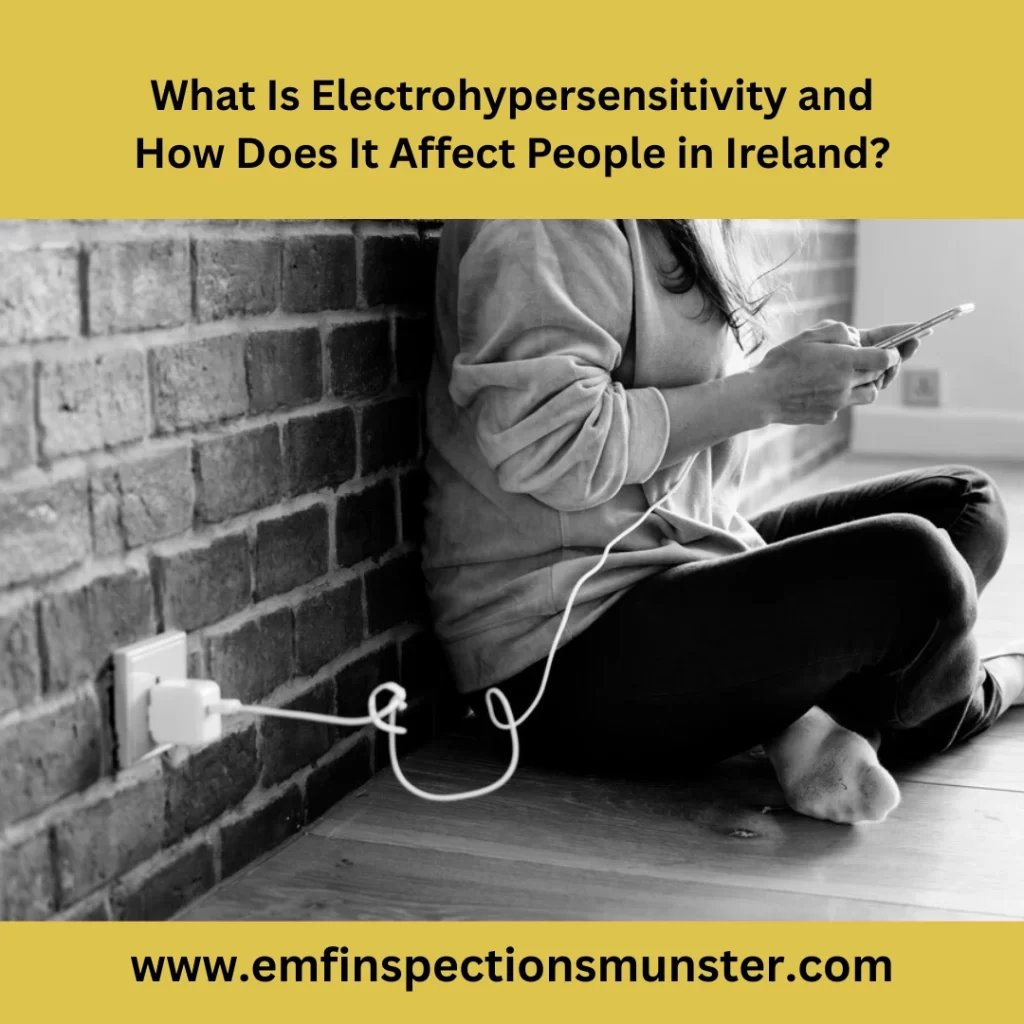As technology continues to evolve and become an inseparable part of daily life, concerns about health effects related to constant exposure to electronic devices and wireless systems are on the rise. One such concern is electrohypersensitivity (EHS), a condition that is gaining increasing attention in Ireland and across the globe. While not officially recognized as a medical diagnosis in many countries, those suffering from electrohypersensitivity report a range of debilitating symptoms triggered by exposure to electromagnetic fields (EMFs).
This blog explores electrohypersensitivity how it impacts individuals in Ireland, and what can be done to manage its effects.
Understanding Electrohypersensitivity
Electrohypersensitivity (EHS), sometimes referred to as electromagnetic hypersensitivity or microwave syndrome, describes a collection of symptoms that some people experience due to exposure to electromagnetic fields (EMFs). These EMFs are emitted by everyday devices such as mobile phones, Wi-Fi routers, smart meters, and even power lines.
While the medical community continues to debate the scientific basis of EHS, sufferers often report symptoms like:
- Headaches
- Fatigue
- Sleep disturbances
- Dizziness
- Concentration difficulties
- Heart palpitations
- Tingling or burning sensations on the skin
These symptoms are generally experienced when individuals are in environments with high levels of electromagnetic exposure and tend to ease when they move away from these sources.
Electrohypersensitivity in the Context of Ireland
In Ireland, the issue of EHS is becoming increasingly visible. With the expansion of 5G networks, smart city infrastructure, and an ever-growing dependence on wireless technology, people are becoming more aware of how EMFs might affect their health.
Though there are no official statistics on the prevalence of electrohypersensitivity Ireland-wide, anecdotal evidence and support groups suggest that the number of people reporting symptoms is growing. Many Irish citizens have started seeking alternative living arrangements away from cities or looking for technologies that help shield them from EMFs.
Ireland’s relatively low population density in rural areas has given some people with EHS the opportunity to relocate to places with lower electromagnetic pollution. However, this is not always feasible for everyone, and the condition can result in significant life disruptions, such as job loss, social isolation, and psychological stress.
Is Electrohypersensitivity Recognized Medically?
The World Health Organization (WHO) does not officially classify EHS as a diagnosable medical condition. However, it does acknowledge that the symptoms experienced by people with EHS are real and can significantly reduce their quality of life. WHO refers to it as idiopathic environmental intolerance attributed to electromagnetic fields (IEI-EMF).
In Ireland, the Health Service Executive (HSE) currently does not provide specific treatment protocols for electrohypersensitivity. Nevertheless, the demand for medical acknowledgment and further research is growing, particularly as more people begin to link their health issues with EMF exposure.
Some healthcare practitioners in Ireland are beginning to take a more holistic approach, combining EMF reduction strategies with dietary, psychological, and environmental interventions.
Common Sources of Electromagnetic Fields in Ireland
People with electrohypersensitivity in Ireland are often triggered by exposure to several common EMF sources, including:
- Mobile phone towers and antennas: Especially those used for 4G and 5G services.
- Wi-Fi routers: Common in homes, schools, libraries, and cafes.
- Smart meters: Increasingly installed by utility providers across Ireland.
- Mobile phones and tablets: Especially when used close to the head or body.
- High-voltage power lines: Found near industrial or rural energy distribution centers.
With EMF sources present nearly everywhere, avoiding exposure entirely is difficult, particularly in urban centers such as Dublin, Cork, and Galway.
Impact on Daily Life and Mental Health
Electrohypersensitivity can significantly impact an individual’s day-to-day functioning. Simple tasks like using a computer, commuting, or shopping in a supermarket can become overwhelming. Many sufferers report feeling misunderstood or dismissed by healthcare professionals and peers, adding to feelings of isolation.
In Ireland, support groups are emerging to provide validation, advice, and practical coping strategies for those affected. Some individuals seek assistance from building biologists or EMF consultants to test their environments and recommend shielding measures.
There are also reports of people becoming reclusive to avoid exposure, which can lead to mental health challenges like anxiety and depression. The Irish mental health community is beginning to recognize these secondary effects and provide support accordingly.
What Is Being Done in Ireland?
While Ireland does not yet officially recognize electrohypersensitivity as a disability or medical condition, there is a growing public and academic interest in EMF exposure. Research is being conducted by universities and independent scientists to explore the potential biological effects of long-term electromagnetic radiation exposure.
In 2022, a motion was raised in the Irish Parliament by concerned members about increasing EMF levels and their health impact. Though not legally binding, it reflects growing public concern. Additionally, some local authorities have started reviewing planning permissions for new telecommunications infrastructure in light of public objections.
For those suffering from EHS, advocacy groups are pushing for policy changes such as:
- Mandatory EMF testing in schools and workplaces
- EMF-free zones in public areas
- Greater awareness and education campaigns
- Development of low-EMF technologies
How to Manage Electrohypersensitivity?
For people in Ireland dealing with electrohypersensitivity, there are several ways to manage the condition:
1. Reduce EMF Exposure
- Turn off Wi-Fi routers when not in use
- Use wired internet connections instead of wireless
- Minimize mobile phone usage; use speaker mode or EMF protection cases
- Avoid sleeping near electronic devices
- Use shielding fabrics or paints for EMF protection in bedrooms
2. Environmental Assessment
Hire an EMF consultant to assess your home or workplace. In Ireland, several trained professionals offer EMF testing services, which can help identify high-exposure areas and suggest mitigation solutions.
3. Supportive Therapies
Consider complementary approaches like:
- Nutritional therapy
- Detoxification programs
- Stress reduction techniques (e.g., mindfulness, yoga)
- Cognitive-behavioral therapy for emotional support
4. Community and Advocacy
Join local or online support groups in Ireland to connect with others facing similar challenges. These communities can provide valuable information, emotional support, and advocacy opportunities.
Calls for Further Research
One of the main challenges for people with electrohypersensitivity is the lack of definitive scientific research that conclusively links EMF exposure with their symptoms. While some small-scale studies show biological changes in EMF-exposed individuals, larger and more controlled studies are needed.
Ireland’s research institutions have an important role to play in exploring the science behind EHS and developing evidence-based guidelines for exposure limits. Public health bodies need to be more transparent in acknowledging potential health risks while promoting balanced and precautionary use of technology.
Conclusion
Electrohypersensitivity is a growing concern in Ireland as society becomes increasingly dependent on wireless and electronic technologies. Although still not fully recognized in the medical community, the lived experience of sufferers cannot be ignored. People dealing with electrohypersensitivity Ireland-wide are advocating for greater recognition, support, and safer technology practices.
The government, health sector, and academic institutions must invest in deeper research and public awareness initiatives. Until then, those affected continue to navigate their condition through environmental control, lifestyle changes, and community support.
As urban areas such as Cork expand technologically, concerns surrounding electromagnetic radiation in Cork and its health effects are also likely to increase. Ireland has a unique opportunity to take a balanced, people-first approach in addressing these modern environmental challenges before they escalate into widespread public health concerns.
Frequently Asked Questions:-
1) What is electrohypersensitivity (EHS)?
- Electrohypersensitivity (EHS) is a condition where individuals experience physical symptoms such as headaches, fatigue, dizziness, and sleep disturbances due to exposure to electromagnetic fields (EMFs) from sources like mobile phones, Wi-Fi routers, and power lines. Though not officially recognized as a medical diagnosis, many people report real and persistent health issues linked to EMF exposure.
2) Is electrohypersensitivity recognized in Ireland?
- As of now, electrohypersensitivity is not officially recognized as a medical condition in Ireland. However, awareness is growing among the public, advocacy groups, and some healthcare professionals. Several individuals are calling for more research and formal support systems to address this condition.
3) What are the common EMF sources that can trigger EHS symptoms in Ireland?
- Common EMF sources in Ireland that may trigger electrohypersensitivity symptoms include mobile phone towers, Wi-Fi routers, smart meters, mobile phones, and high-voltage power lines. These are prevalent in both urban and rural settings across the country.
4) How can people in Ireland manage electrohypersensitivity?
- Managing EHS involves reducing EMF exposure by turning off Wi-Fi when not in use, using wired internet connections, minimizing mobile phone use, and implementing shielding measures in the home. Supportive therapies and consultations with EMF specialists can also help improve symptoms.
5) Why is there concern about electromagnetic radiation in Cork and other Irish cities?
- As cities like Cork rapidly adopt 5G technology and smart infrastructure, concerns are growing about the potential health effects of increased electromagnetic radiation. Residents, particularly those with EHS, are advocating for more research, EMF-free zones, and safer technology usage to protect public health.


